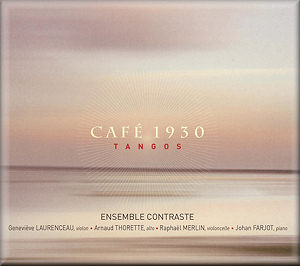 |
 |
|


alternatively
CD: AmazonUK
AmazonUS
|
Café 1930
Astor PIAZZOLLA (1921-1992)
Adios Nonino [4:51], Oblivion [2 :39]
S.
YRADIER
La Paloma [6:19]
Astor
PIAZZOLLA
Café 1930 [7:42], Contraste [2 :54]
C. GARDEL & A.
LE PERA
El dia que me querias (1741) [6:14]
Astor
PIAZZOLLA
La Misma Pena [5:39], Milonga del angel [7 :21]
J. C. SAUNDERS & C.
VEDANI
Adios Muchachos [3:42]
Astor
PIAZZOLLA
Invierno Porteno [5 :06], Tangata [2 :47],
Saint-Louis-en-L’ile [3 :14]
G.
H. M. RODRIGUEZ
La Cumparsita [3 :10]
Astor
PIAZZOLLA
Oblivion [13:30]
 Ensemble
Contraste: (Arnaud Thorette (viola); Johan Farjot (piano); Geneviève
Laurenceau (violin), Raphaël Merlin (cello), Magali Léger
(soprano), Karine Deshayes (mezzo)) Raphaël Imbert (saxophone),
André Ceccarelli (drums) ; Paris-Sorbonne Choir/Denis
Rouger Ensemble
Contraste: (Arnaud Thorette (viola); Johan Farjot (piano); Geneviève
Laurenceau (violin), Raphaël Merlin (cello), Magali Léger
(soprano), Karine Deshayes (mezzo)) Raphaël Imbert (saxophone),
André Ceccarelli (drums) ; Paris-Sorbonne Choir/Denis
Rouger
rec. 13-17 October 2008, Eglise de Bonsecours, Paris. DDD
 ZIGZAG ZZT090103 [75:54]
ZIGZAG ZZT090103 [75:54]  |
|
|
Beginning with Piazzolla’s Adios Nonino, this disc explores a number of tangos arranged for violin, viola, cello and piano. The arrangements are colourful and imaginative. The well-known Oblivion appears in versions for viola and piano, for quartet with choir and for piano, cello, saxophone and drums.
Adios Nonino makes a good opening track, with its upbeat tango style showing the flair this ensemble has to offer. By contrast, the first of the Oblivion appearances
is mellow and contemplative, with the solo viola line providing
a sound quality one is perhaps unused to hearing in Piazzolla’s music. The Spanish style comes through in Yradier’s La Paloma,
heard in a light orchestration for strings and piano. A subtle
hint at Ravel’s Bolero comes through in the accompaniment, which is both amusing and effective.
The title track, Café 1930 comes from Piazzolla’s L’Histoire
du Tango, more usually heard in its version for violin or flute and guitar. This arrangement uses the quartet with choir; an unusual but effective sound. The melody line is mostly taken up by the violin with accompaniment from cello or piano. The use of the choir is reserved for filling out harmonies subtly at the opening and in small sections later on. The cello takes over the melody in the somewhat reticent central section, providing an enjoyable change of colour before the violin takes over once again.
Contraste is given a strongly rhythmic and energetic performance, which is full of the passionate gestures, gusto and rubato one associates with the tango style. The Gardel and Le Pera track, El dia que me querias was reminiscent of music from an early movie, with vocal lines added to the quartet sound. Here Hollywood style schmaltz is combined with classical pastiche. I found this arrangement a little too saccharine for my palate, but the vocal lines blended nicely and were well-executed. La Misma Pena was more enjoyable, with a dark, low opening breaking into a more cheerful mood later in the piece.
Normally mid-way through a tango CD, I begin to feel like I’ve
had a bit too much of a good thing. In some ways, this disc
falls quite well into that pattern. By track 8, Milonga del Angel,
I found myself a little tired of the genre and in need of some
variety. The addition of the choir to this track was interesting,
and although the ‘aahing’ was slightly reminiscent
of a sci-fi film soundtrack, the timbral contrast was welcome. Adios Muchachos has some enjoyable pizzicato effects, while Invierno Porteno has varied contrasts and textures. The Romanticism of Tangata is well conveyed and St-Louis-en-L’Ile has
a bitingly rhythmic opening which is full of drama. This fiery
performance is extremely enjoyable, with Piazzolla’s
charismatic music full of energy here. La Cumparsita is the traditional tango theme which usually comes to mind when tango is mentioned. This arrangement includes fast-moving lines for the strings and these serve to decorate the theme.
The remaining two arrangements of Oblivion bring the disc to a close. I found the jazz version, heard in between sections for quartet, particularly enjoyable. This added dimension made a wonderful addition to the disc.
Overall, this is an enjoyable disc, with a good selection of
Piazzolla’s music interspersed with some other classics
of the repertoire. However, I found it difficult to listen
to the complete disc without becoming tired of the instrumental
combination, and would have liked more variety in a disc of
this length.
Carla Rees
|
|
|

